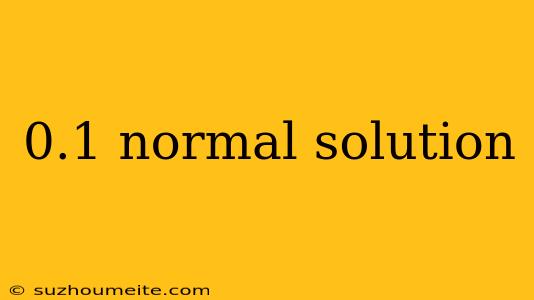0.1 Normal Solution: Understanding the Concept and Applications
In chemistry, a normal solution is a solution that contains one gram equivalent of solute per liter of solution. The normality of a solution is denoted by the symbol 'N' and is calculated by dividing the number of gram equivalents of solute by the volume of the solution in liters.
What is a 0.1 Normal Solution?
A 0.1 normal solution, also denoted as 0.1 N, is a solution that contains 0.1 gram equivalents of solute per liter of solution. This means that if you have 1 liter of a 0.1 N solution, it contains 0.1 gram equivalents of solute.
Calculating Normality
To calculate the normality of a solution, you need to know the number of gram equivalents of solute and the volume of the solution. The formula to calculate normality is:
N = Number of gram equivalents / Volume of solution (in liters)
For example, if you have 20 grams of sodium hydroxide (NaOH) dissolved in 1 liter of water, the number of gram equivalents is:
Number of gram equivalents = Mass of NaOH / Equivalent weight of NaOH = 20 g / 40 g/equivalent = 0.5 equivalents
Now, you can calculate the normality:
N = 0.5 equivalents / 1 liter = 0.5 N
Applications of 0.1 Normal Solution
0.1 Normal solutions have several applications in various fields:
Analytical Chemistry
In analytical chemistry, 0.1 N solutions are used as standards for titration reactions. Titration is a process used to determine the concentration of an unknown solution.
Pharmaceuticals
In the pharmaceutical industry, 0.1 N solutions are used to prepare medications and vaccines.
Laboratory Experiments
0.1 N solutions are commonly used in laboratory experiments, such as acid-base titrations and redox reactions.
Quality Control
In quality control, 0.1 N solutions are used to test the purity of substances and materials.
Conclusion
In conclusion, a 0.1 normal solution is a solution that contains 0.1 gram equivalents of solute per liter of solution. Understanding normality and how to calculate it is essential in various fields, including analytical chemistry, pharmaceuticals, laboratory experiments, and quality control.
